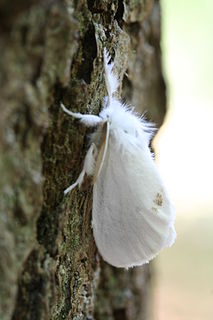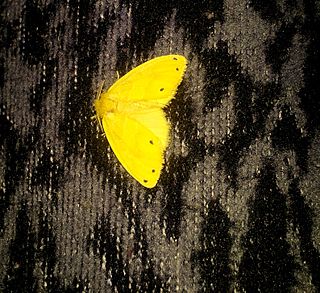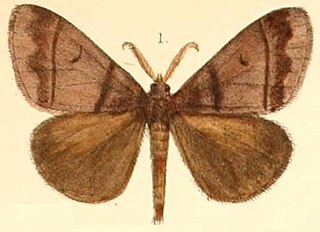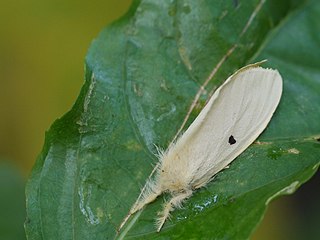Related Research Articles

The yellow-tail, goldtail moth or swan moth is a moth of the family Erebidae. The species was first described by Johann Kaspar Füssli in 1775, and has commonly been placed within the related genus Euproctis. It is distributed throughout Europe to the Urals, then east across the Palearctic to Siberia and south to India and Sri Lanka.

Tarucus nara, the striped Pierrot, is a small butterfly found in Sri Lanka and south India that belongs to the lycaenids or blues family.

Artaxa is a genus of tussock moths in the family Erebidae erected by Francis Walker in 1855. Some of the species have urticating hairs.

Euproctis is a genus of tussock moths in the family Erebidae described by Jacob Hübner in 1819. Species are cosmopolitan, widespread throughout Palearctic, African, Oriental and Australian regions. Molecular phylogenetic studies indicate that the genus as presently understood comprises a large number of unrelated lineages, only a few of which have names, and is therefore in serious need of revision.

Sphrageidus is a genus of tussock moths in the family Erebidae. It is considered a synonym of the related genus Euproctis by some authors, but still recognized as valid by others (e.g.), and supported as distinct in molecular phylogenetic studies.
Artaxa angulata is a moth of the family Erebidae first described by Shōnen Matsumura in 1927. It is found in Taiwan, Myanmar, India, Pakistan, Sri Lanka, Malaysia, Singapore and Indonesia.
Artaxa vitellina is a moth of the family Erebidae first described by Vincenz Kollar in 1848. It is found in India and Sri Lanka.
Psalis pennatula, the yellow hairy caterpillar, is a moth of the family Erebidae. The species was first described by Johan Christian Fabricius in 1793. It is found in India, Sri Lanka, Thailand, Australia and Java.
Euproctis bimaculata is a moth of the family Erebidae first described by Francis Walker in 1855. It is found in India, Sri Lanka and Thailand.

Euproctis cervina is a moth of the family Erebidae first described by Moore in 1877. It is found in Sri Lanka.
Euproctis fraterna is a moth of the family Erebidae first described by Moore in 1883. It is found in the Maldives, India, Sri Lanka and the Seychelles.
Euproctis fulvipuncta is a moth of the family Erebidae first described by George Hampson in 1893. It is found in India and Sri Lanka.

Euproctis lunata, the castor hairy caterpillar, is a moth of the family Erebidae. The species was first described by Francis Walker in 1855. It is found in India, Pakistan, Sri Lanka and Thailand.

Euproctis latifascia is a moth of the family Erebidae first described by Francis Walker in 1855. It is found in India, Sri Lanka and Taiwan.
Euproctis rhoda is a moth of the family Erebidae first described by Moore in 1879. It is sometimes classified as a subspecies of Euproctis howra. It is found in India, Sri Lanka, Myanmar, the Andaman Islands and Australia.
Euproctis semisignata is a moth of the family Erebidae first described by Francis Walker in 1865. It is found in India and Sri Lanka.

Euproctis varians is a moth of the family Erebidae first described by Francis Walker in 1855. It is found in India, Sri Lanka, the Maldives, Celebes and China.
Laelia exclamationis is a moth of the family Erebidae first described by Vincenz Kollar in 1848. It is found in Sri Lanka, India and Taiwan.
Trachea melanospila is a moth of the family Noctuidae first described by Vincenz Kollar in 1844. It is found in Sri Lanka, Korea, Japan and Siberia.
Nola analis is a moth of the family Nolidae first described by Wileman and West in 1928. It is found in India, Sri Lanka and Hong Kong.
References
- ↑ "Species Details: Sphrageidus xanthorrhoea Kollar, 1848". Catalogue of Life. Retrieved 7 March 2018.
- ↑ Koçak, Ahmet Ömer; Kemal, Muhabbet (20 February 2012). "Preliminary list of the Lepidoptera of Sri Lanka". Cesa News. Centre for Entomological Studies Ankara (79): 1–57 – via Academia.
- ↑ Savela, Markku. "Euproctis xanthorrhoea (Kollar, 1848)". Lepidoptera and Some Other Life Forms. Retrieved 15 October 2018.
- ↑ "Food plants of Sphrageidus". Lepidoptera HOSTS. Retrieved 7 March 2018.
- ↑ "HOSTS - a Database of the World's Lepidopteran Hostplants". The Natural History Museum. Retrieved 7 March 2018.
| This article on a moth of the subfamily Lymantriinae is a stub. You can help Wikipedia by expanding it. |